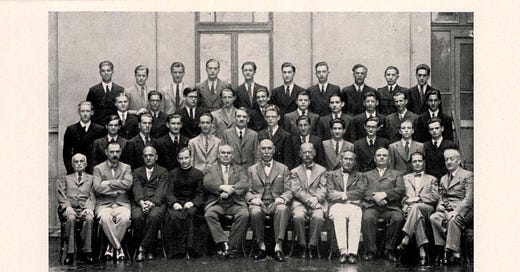Over the past few weeks, I’ve found several documents related to Opapa’s high school, Eötvös József Gimnázium in Budapest. The most interesting discovery is the school yearbook, which includes pictures of students as well as students grades (!). It also describes the courses that students were required to take.
I’ve just gotten started digging into these documents, but I want to share a few initial discoveries.
First, I loved seeing Opapa’s class picture. He’s in the back row, middle-right, next to George Gál, who would also emigrate to the US and become a life-long friend.
On the next page, all student grades are printed:
Now, there are a couple surprises on this page. One is his grades (a story for a different post), which are — contrary to what Opapa always said — very good. The second surprise are the three letters next to Opapa’s name: “izr.”
What could they mean, I wondered? I scanned up and down, and saw that several people were listed as “izr,” while others were “r.k.” and some were “ev.”
It didn’t take me too long to guess that “izr” meant “izraelita,” or “Israelite,” the term used to refer to people of the Jewish religion.
I confirmed this with my translator, and asked about the other abbreviations. Here is what they represent:
r.k. = római katolikus / Roman Catholic
g.k. = g.k. = görög katolikus / Greek Catholic
ref. = református / Calvinist
ev. = evangélikus / Lutheran
izr. = izraelita / Israelite
As an American raised with very specific ideas about church/state separation, particularly in schools, it was shocking to see each student’s religion listed so publicly next to their grades. But then I remembered: in Germany, where I worked in a Gymnasium for a year, every student took a “Religion” class, and each student registered their Religion with the State (ie. evangelisch, katolisch). You can now choose to register as “atheist,” in which case your “religion” class is an ethics class, and you don’t have to pay a tax to a religious institution. According to my translator, it is the same in Hungary today.
But in the 1930s, there was no “atheist” option: only Roman Catholic, Greek Catholic, Calvinist, Lutheran, or Israelite. And there were five separate classes, one for each religion. A different instructor taught each course:
The “Israelite” teacher was Dr. Márton Kósa, a rabbi. And fortunately for me, the yearbook actually describes each class quite extensively. Here is what students - including Opapa - would have learned in the “Israelite” class:
For Classes 3-8, Káldi László, choirmaster of the Városi Színház [City Theatre] was entrusted by the Israelite community of Pest to teach the liturgical songs of the major holidays during one of the Religion classes each week in the month of April and May. The Israelite students attended a service at the Dohány Street Synagogue on Fridays during the first semester, and on Saturdays during the second semester. Besides the services held at the opening and closing ceremonies of the school year, the students attended services on the patriotic national holidays at the Dohány Street Synagogue. In addition to this, the students of Class 8 having a final exam this year attended a service on April 30.
According to the yearbook, Jewish students learned “liturgical songs” for the Jewish holidays, and they “attended a service at the Dohány Street Synagogue on Fridays during the first semester, and on Saturdays during the second semester.”
I looked up the Dohány Street Synagogue, and it is a beautiful building about a 6 minute walk from Ëotvös Gimnázium:
Apart from the fact that religion was so prominent within the school culture, this information was shocking to me for a few other reasons: first, even after I learned that Opapa had Jewish heritage, for some reason I assumed he had no formal education in Judaism. I don’t think he was a member of a synagogue, but it seems that he was required to have quite an extensive degree of religious education from his high school. So he must have known much more about Judaism that I had assumed.
Second, since everyone’s religion is listed, we can see very clearly the religious mix of Opapa’s class. There were quite a lot of Jews (including Opapa’s friend George Gál). In Opapa’s class of 33, here is the breakdown:
r. k. (Roman Catholic) 19 students
izr. (Jewish): 10 students
ref. (Calvinist): 2 students
ev. (Lutheran): 2 students
Jews are in the minority, but they still make up about 30% of the class.
Seeing all of this information about religion listed so publicly makes me anxious. Perhaps that’s because I know what’s coming, or perhaps it’s my American sensibilities. But they even list the home addresses of the Religion teachers!
My guess is that Opapa didn’t like this system either, and that’s one reason he never talked about it.
I also wonder whether this is one of the reasons he and Omama named their second son “Thomas Jefferson” Gerbner, after the man who wrote not only the Declaration of Independence, but also coined the phrase “wall of separation” to refer to the relationship between church and state.
Here is Jefferson’s famous letter to the Danbury Baptists, which he wrote in 1802, and which I think Opapa would have appreciated:
Believing with you that religion is a matter which lies solely between Man & his God, that he owes account to none other for his faith or his worship, that the legitimate powers of government reach actions only, & not opinions, I contemplate with sovereign reverence that act of the whole American people which declared that their legislature should "make no law respecting an establishment of religion, or prohibiting the free exercise thereof," thus building a wall of separation between Church & State.








Another great article (but scary to see the inclusion of religion info on a school roster). Keep up the good work!